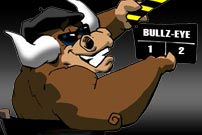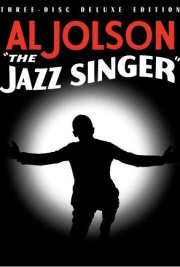 With the temperature dropping, it's time to find someone to keep you warm. Find your hookups with our online dating guide!
With the temperature dropping, it's time to find someone to keep you warm. Find your hookups with our online dating guide!
- Rated NR
- Drama
- 1927
- Buy the DVD
Reviewed by Will Harris
()
"Oy vey's mir! You have brought shame on our family! If you were a musician or a jazz singer, this I could forgive…"
– Rabbi Hyman Krustofsky to his son, Krusty the Klown, on “The Simpsons”
Yes, even “The Simpsons” have paid tribute to “The Jazz Singer.” It’s just that important a movie. It wasn’t the first “talkie,” but it was certainly the one that proved the medium of motion pictures with sound could indeed be financially successful -- just as long as the technology could keep the mouths and the voices in synch. The film goes beyond its technological achievement, however, as it tells the story of a son who defies both his father and five generations of family tradition in order to follow his heart, only to find that you can’t achieve true happiness when you’re spending all your time running from your past.
The film starts not with Jolson but, rather, with Bobby Gordon playing Jakie Rabinowitz, a 13-year-old with an ear for a good ragtime number, one which leads him to a regular gig at a local beer hall. Jakie has decidedly less enthusiasm for the songs he’s been forced to learn for his future role as a cantor, but given that his father (Warner Oland) loathes ragtime, jazz and just about any other kind of modern music, the beer hall is the only place he can really strut his stuff. Unfortunately, family friend Moisha Yudelson (Otto Lederer) spills the beans when he stumbles across Jakie singing one day, which leads to a confrontation between father and son -- i.e., a beatin’. End result: Jakie leaves with the assurance that he won’t be returning, Papa declares that he has no son, and Mama (Eugenie Besserer) sobs her eyes out.
The next thing you know, it’s many years later, and Jakie Rabinowitz is now Jack Robin, and, even better, he’s Al Jolson, too! He hasn’t quite made a superstar out of himself yet, but he knows it’s only a matter of time, and as fate would have it, that time occurs almost immediately after we pick up his story. In one fell swoop, Jack falls in love and ends up getting his big break…though when he writes his mother about both things, her first thought is, “"Maybe he's fallen in love with a shiksa.” (Moms, huh? What can you do?) Inevitably, the vaudeville circuit finds Jack back in his hometown of Chicago, which leads to a reunion with his parents, with one of them decidedly less thrilled than the other to see him.
We could delve further into the details of the plot, but if you’ve never seen it, we don’t want to spoil it for you; it’s a great movie, sound or no sound. Ultimately, though, it is the sound that sells it, specifically Jolson’s singing. Those who’ve never seen the film, however, may be surprised to find that it’s actually still mostly a silent picture, minus Jolson’s numbers – which includes “Toot, Toot, Tootsie (Goo’Bye),” “Blue Skies,” and “My Mammy” – and the few snatches of conversation which surround them. In other words, get ready to do some reading. As to the now-controversial scenes where Jolson is sporting blackface, they’re really not all that controversial. Though the look itself may prove disconcerting to some, it’s simply the make-up he’s wearing in the scene as part of his act, with very little mention being made of it (well, aside from his mother’s comment that he looks like a shadow of himself when he’s wearing it, that is). The point, though, is that it’s not like he’s walking around, trying to talk like a racial stereotype, so if you can just accept it within its proper historical context, there’s very little attention drawn to it within the film itself.
“The Jazz Singer” is an age-old story of the battle between generations, so timeless that it’s no wonder it’s been remade on three separate occasions, but there’s one thing that neither Neil Diamond nor Danny Thomas nor even Jerry Lewis had in their versions: the unrivaled showmanship and charisma of Al Jolson.
Three-Disc Deluxe Edition DVD Review:
As befits one of the most historically significant films in the history of motion pictures, “The Jazz Singer” has been tricked out with special features and packaging that easily match its stature.
Disc One begins, unsurprisingly, with a gorgeous transfer of the film itself, accompanied by an audio commentary with Ron Hutchinson, founder of the Vitaphone Project, and Vince Giordano, leader of Vince Giordano’s Nighthawks. Although there are four vintage shorts which purport to be “featuring Al Jolson,” three of them – “A Day at Santa Ana,” “Hollywood Handicap,” and “An Intimate Dinner in Celebration of Warner Bros.’ Silver Jubilee” – only offer brief appearances from the man. The fourth, however, is the much-celebrated “A Plantation Act,” which was filmed in 1926 and is nothing but non-stop Jolson. Decked out in blackface and standing before a backdrop of a prosperous field, he belts out renditions "April Showers," "Rock-a-Bye Your Baby with a Dixie Melody," and "When the Red Red Robin Comes Bob-Bob-Bobbin' Along.” There’s also an audio recording of the radio adaptation of “The Jazz Singer,” a collection of trailers from not only “The Jazz Singer” but also five other Jolson films, and – yes! – the “Jazz Singer”-inspired Warner Bros. cartoon, “I Love to Singa.” (“…’bout the moon-a and the June-a and the spring-a…”)
The highlight of Disc Two is the new feature-length documentary, “The Dawn of Sound: How Movies Learned to Talk,” which should be required viewing for anyone who has anything to do with the movie business. Starting in the days of Edison, the documentary follows the story of the “talkies” and, possibly surprising those who’ve never seen “Singin’ in the Rain,” spends a considerable amount of time discussing how audiences actually laughed in the face of Hollywood’s first attempts at meshing sound with motion pictures. The combination of Vitaphone and Jolson proved impossible for moviegoers to resist, however, and the rest is history. Particularly interesting, however, is Leonard Maltin’s observation about how Hollywood got so excited about the success of “The Jazz Singer” that they’d dismiss a brilliant silent film in a heartbeat to make a movie with sound, no matter how crappy it was. Beyond the doc, they’ve also included the surviving sound excerpts from “Gold Diggers of Broadway,” which had been believed completely lost. It’s worth checking out to see a performance of “Tiptoe through the Tulips” before Tiny Tim got his mitts on it. Finally, there are five studio shorts described as being “from or celebrating the early sound era;” they’re all interesting artifacts, but the most amusing is “Finding His Voice,” an animated feature from the legendary Max Fleischer where a little dude named Talkie takes his friend Mutie (ho, ho, HO!) to the Western Electric sound lab to help him find his voice.
It’s Disc Three which will thrill fans of the entertainers from the 1920s and 1930s, as it contains 4+ hours of rare and historic Vitaphone shorts that have, in some cases, not been seen since their original theatrical showings. There’s no Jolson, but – and I know this is blasphemy, so forgive me – it hardly matters, given that what we do have is material presenting an invaluable look at the entertainment to which our grandparents or great-grandparents may have been thrilling. George Burns and Gracie Allen in “Lambchops” is probably the selection that will receive the most interest, if only because of Burns’s career longevity, but fans of “The Dick Van Dyke Show” will be fascinated to see Baby Rose Marie in “The Child Wonder.” (Personally, I most enjoyed Van and Schneck, a.k.a. “The Pennant Winning Battery of Songland,” and their performance of “She’s Full of Onions.”)
But hold on, hold on, you ain’t seen nothin’ yet!
As if the discs themselves aren’t enough, there are postcards offering backstage and behind-the-scenes photos of Jolson; reproductions of a Vitaphone pamphlet from the 1920s that explained the technology for the curious moviegoer; the original program and souvenir booklet for “The Jazz Singer;” and – most interestingly for those who’ve watched the documentary – a reproduction of the telegram Jolson sent Jack Warner after the death of Warner’s brother, Sam, who spearheaded “The Jazz Singer” but died on the eve of the film’s premiere. (“When you lost one brother,” wrote Jolson, “you found another one.”)
That’s right: if you buy this set, you get an unparalleled lesson in the history of motion pictures, complete with visual aids. Actually, there shouldn’t even be an “if” involved. “The Jazz Singer: Three-Disc Deluxe Edition” should be in the collection of anyone who claims to love movies, period. If it isn’t, then you don’t love movies nearly as much as you think you do.
You can follow us on Twitter and Facebook for content updates. Also, sign up for our email list for weekly updates and check us out on Google+ as well.











